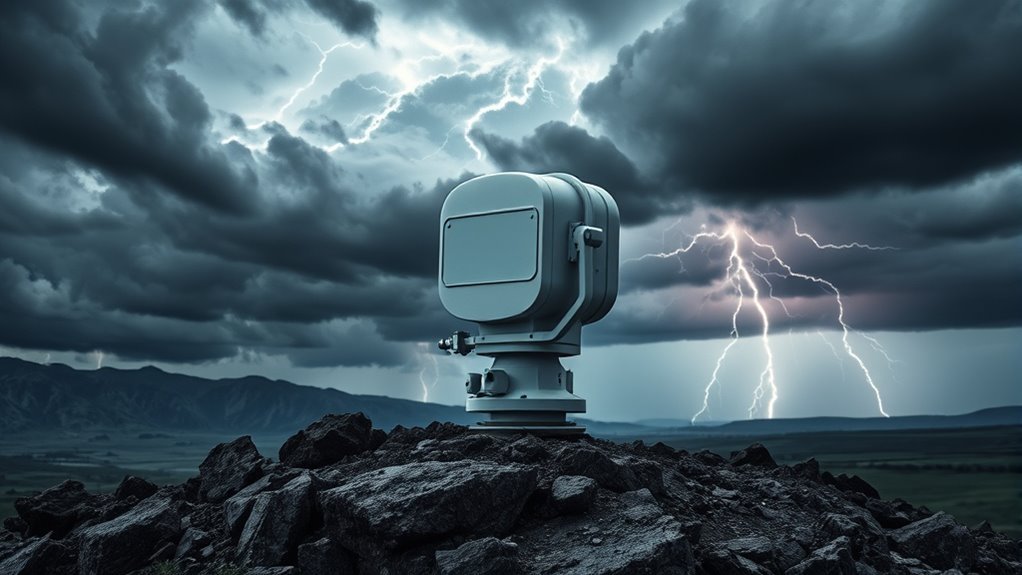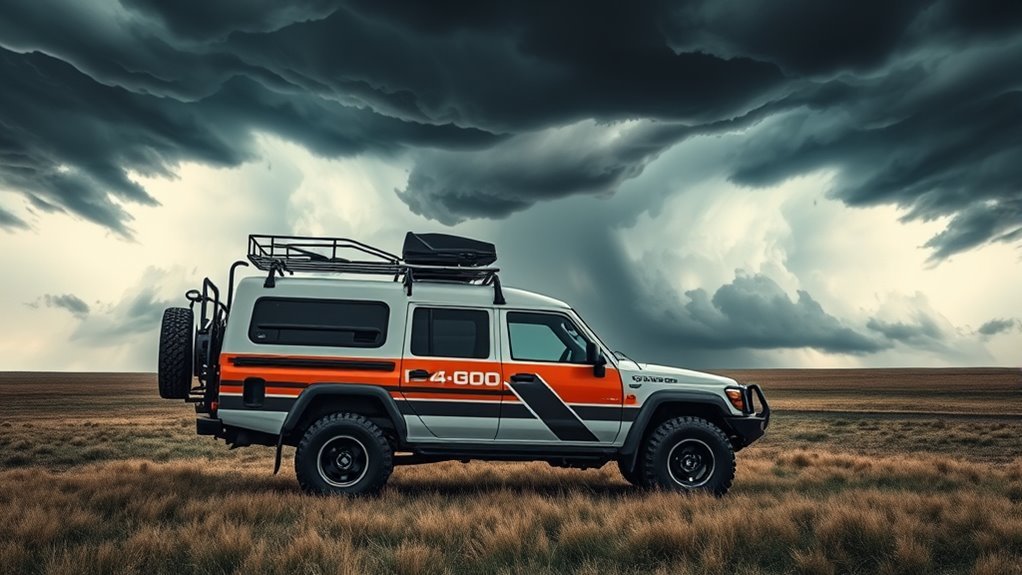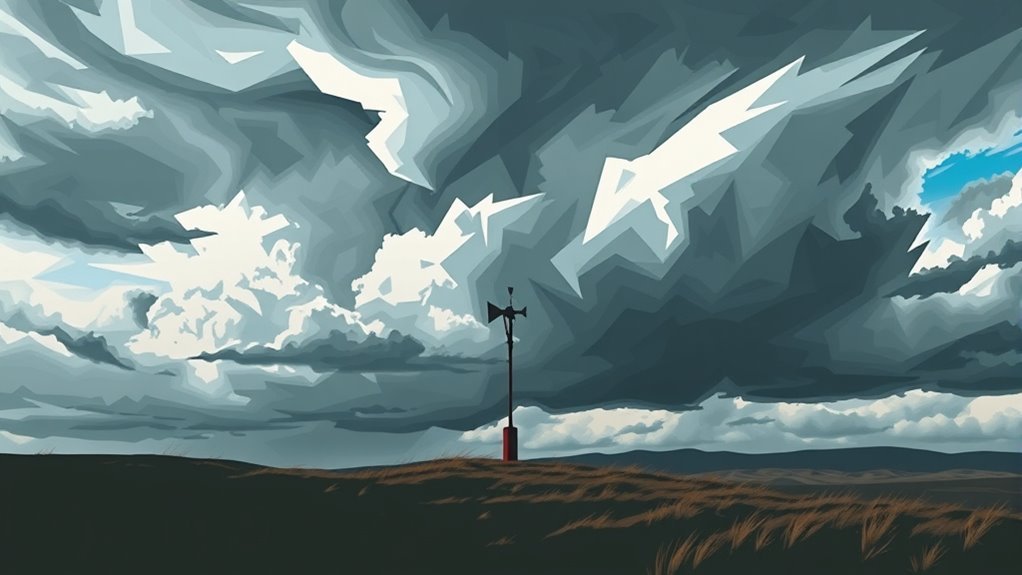Storm chasers document squalls and their extreme conditions using high-quality cameras, weather-resistant gear, and advanced meteorological instruments. They employ systematic data collection methods and maintain situational awareness during storms. By utilizing drones and mobile weather stations, they capture real-time data from various viewpoints. Rigorous analysis of the data allows for trend identification and refined forecasting. Their efforts considerably improve public awareness of severe weather, contributing to safety and preparedness strategies. More understanding awaits on this fascinating topic.
Main Points
- Storm chasers use high-quality cameras and weather-resistant housing to capture dramatic imagery of squalls and extreme weather conditions.
- Advanced meteorological instruments like anemometers and barometers are employed to gather precise data during severe weather events.
- Mobile weather stations and drones provide real-time data collection and aerial perspectives of squall phenomena.
- Safety protocols, including situational awareness and clear communication, are essential for storm chasers working in hazardous conditions.
- Regular equipment calibration ensures accurate measurements and improves the integration of data collected during squall events.
The Role of Storm Chasers in Meteorology
Although storm chasers often pursue extreme weather out of passion, their contributions to meteorology extend far beyond personal interest. These dedicated individuals play a significant role in collecting real-time data during severe weather events, which is essential for understanding storm dynamics.
By documenting storms, they provide meteorologists with important information about wind patterns, precipitation rates, and storm formation processes. Storm chasers often collaborate with research institutions, sharing their observations to improve weather models and refine forecasting accuracy.
Their firsthand experience in the field allows them to capture phenomena that may not be observed through traditional radar systems. Additionally, their work aids in public safety efforts, as they can relay immediate information about dangerous conditions to local communities.
In essence, storm chasers serve as both observers and informants, bridging the gap between theoretical meteorology and practical application, ultimately benefiting the scientific community and society as a whole.
Essential Equipment for Documenting Squalls

Essential apparatus is essential for storm chasers aiming to document squalls effectively. High-quality cameras capable of capturing fast-moving events are essential; DSLR or mirrorless models with rapid burst shooting features are preferred. Weather-resistant housing protects apparatus from harsh elements, ensuring functionality in extreme conditions.
Additionally, portable tripods provide stability for capturing long-exposure shots, while drones offer unique aerial viewpoints of squall formations. Storm chasers also rely on advanced meteorological instruments, such as anemometers and barometers, to measure wind speed and pressure changes accurately.
Moreover, communication tools, including satellite phones and two-way radios, enable coordination among chasers and improve safety during extreme events.
Finally, a reliable vehicle equipped with GPS navigation and ample storage for apparatus is essential for swift maneuvering in unpredictable weather. Together, this essential gear enables storm chasers to document squalls and contribute significant data to meteorological research.
Techniques for Capturing Extreme Weather
Effective techniques for capturing extreme weather involve careful selection of camera equipment, compliance with safety protocols, and systematic data collection methods.
Storm chasers must prioritize high-quality gear to withstand harsh conditions while ensuring personal safety.
Additionally, organized data collection is vital for analyzing weather patterns and enhancing future storm tracking efforts.
Camera Equipment Choices
When storm chasers prepare to document extreme weather, their choice of camera equipment plays a vital role in capturing the intensity and nuances of squalls. High-resolution DSLR and mirrorless cameras are often preferred for their superior image quality and versatility.
These gadgets allow chasers to switch lenses, enabling them to modify to varying distances and conditions. Additionally, weather-sealed bodies are essential for withstanding harsh elements like rain and wind.
Many chasers also employ action cameras for wide-angle shots and drones for aerial viewpoints, providing unique views of the storm's structure. Tripods and stabilizers help guarantee steady shots, while remote triggers allow for capturing moments without physical interference.
This careful selection of equipment improves the documentation of extreme weather phenomena.
Safety Protocols Implemented
Choosing the right camera equipment is only one aspect of storm chasing; implementing safety protocols is equally important for capturing extreme weather.
Storm chasers prioritize their safety by adhering to strict guidelines, such as maintaining a safe distance from the storm and using reliable communication methods. They often utilize weather radar and storm tracking apps to monitor conditions in real-time, enabling quick decision-making.
Additionally, many chasers travel in groups to improve safety, allowing for shared resources and support. Adopting a "safe spot" strategy guarantees they have predetermined locations to retreat to in case of sudden changes in weather.
Data Collection Methods
While storm chasers employ various techniques to capture extreme weather, data collection methods play a crucial role in their efforts.
Chasers utilize advanced tools such as anemometers to measure wind speed, barometers to assess atmospheric pressure, and thermometers to monitor temperature changes. High-definition cameras and drones provide visual documentation, capturing the intensity and structure of storms.
Additionally, GPS gadgets track storm movement, enabling chasers to position themselves strategically. Many teams also employ mobile weather stations that relay real-time data back to meteorological networks.
This extensive approach to data collection not only improves the understanding of squalls but also contributes important information to weather forecasting and research, ultimately aiding in public safety efforts during severe weather events.
Safety Protocols for Storm Chasing

Although storm chasing can be an exhilarating pursuit, it demands strict compliance to safety protocols to protect both chasers and the public. Adhering to these guidelines not only improves personal safety but also contributes to the general effectiveness of storm documentation.
- Situational Awareness: Chasers must remain vigilant, constantly monitoring weather updates and changes in storm behavior to avoid dangerous conditions.
- Vehicle Preparedness: Properly equipped vehicles are essential. This includes having a full tank of gas, emergency supplies, and communication tools to guarantee rapid evacuation if necessary.
- Team Coordination: Working in groups improves safety. Chasers should establish clear communication channels and designate roles to manage tasks efficiently.
Analyzing Data Collected During Squalls

Analyzing the data collected during squalls requires a variety of techniques to guarantee accuracy and relevance.
Weather patterns are scrutinized to identify trends and anomalies, while the importance of equipment calibration cannot be overstated, as precise measurements are critical for reliable analysis.
Understanding these elements is essential for storm chasers aiming to improve their knowledge and response strategies.
Data Collection Techniques
Data collection during squalls is critical for understanding their dynamics and predicting their impact. Storm chasers employ various techniques to gather essential data that can inform meteorological research and public safety measures. They utilize specialized equipment and methodologies to guarantee accuracy and reliability.
- Mobile Weather Stations: These are deployed in the field to capture real-time meteorological data such as temperature, humidity, and wind speed.
- Drones: Equipped with sensors, drones provide aerial perspectives into squall structure and behavior, reaching areas that are otherwise inaccessible.
- High-Definition Cameras: Visual documentation helps in studying the visual phenomena associated with squalls, including cloud formations and precipitation patterns.
These techniques collectively improve the understanding of squalls and their complex characteristics.
Weather Patterns Analysis
A thorough analysis of weather patterns during squalls reveals critical understandings into their formation and behavior. Meteorologists employ various data sets, including temperature, humidity, wind speed, and atmospheric pressure, to identify trends and anomalies associated with squall events.
By examining these variables over time, they can recognize the conditions that typically precede and accompany squalls, thereby improving predictive models. Additionally, the spatial distribution of squalls helps researchers assess their intensity and duration, which are essential for issuing timely warnings.
Understanding the interplay between these factors not only improves forecasting accuracy but also aids in developing strategies for public safety during extreme weather events. In the end, this analysis contributes to a broader comprehension of squall dynamics and their impacts on local climates.
Equipment Calibration Importance
While squalls present unique challenges for meteorological study, the importance of equipment calibration cannot be overstated. Accurate data collection hinges on properly calibrated instruments, guaranteeing reliable observations into extreme weather conditions.
Key aspects of equipment calibration include:
- Precision Measurement: Guarantees that sensors provide consistent and accurate readings, vital for evaluating wind speed and precipitation levels.
- Timeliness: Regular calibration allows for immediate adjustments, important during rapidly changing squall conditions.
- Data Integration: Well-calibrated equipment promotes the seamless merging of data from various tools, enhancing comprehensive analysis.
Inadequate calibration can lead to erroneous conclusions, misinforming forecasts and potentially endangering lives.
Consequently, maintaining rigorous calibration protocols is essential for effective storm chasing and accurate squall documentation.
The Impact of Storm Chasing on Public Awareness
How does storm chasing influence public awareness of severe weather events? This phenomenon plays a critical role in shaping the public's understanding of extreme weather.
Storm chasers often share real-time data and visuals through social media platforms, allowing individuals to witness the intensity and unpredictability of squalls firsthand. This immediate access to information raises public vigilance, encouraging communities to better prepare for impending storms.
Moreover, storm chasers collaborate with meteorologists, providing essential insights that improve forecasting accuracy. Their observations help disseminate warnings more effectively, nurturing a culture of safety and awareness.
The dramatic imagery captured by chasers serves not only to inform but also to engage audiences emotionally, bridging the gap between scientific data and personal experience.
In general, storm chasing greatly boosts public awareness, transforming how society perceives and responds to severe weather events.
Future Trends in Storm Chasing Technology
As advancements in technology continue to reshape various fields, storm chasing is poised for substantial transformation. Future trends indicate a shift towards more sophisticated tools that improve safety and data collection for storm chasers.
- Drones: Equipped with high-resolution cameras and sensors, drones are set to provide real-time data from within storm systems, offering understanding previously inaccessible from the ground.
- Artificial Intelligence: AI algorithms will aid in predicting storm behavior, improving decision-making for chasers and increasing public safety alerts.
- Wearable Technology: Gadgets such as smart helmets and augmented reality glasses will allow chasers to access crucial information hands-free, keeping their focus on the environment around them.
These advancements promise to revolutionize the storm chasing environment, making it safer and more effective in documenting extreme weather events while contributing to broader meteorological research.
Common Questions
What Motivates Individuals to Become Storm Chasers?
Individuals are often motivated to become storm chasers by a deep fascination with nature's power, a desire for adventure, the thrill of capturing extreme weather phenomena, and a commitment to understanding and documenting these events for scientific purposes.
How Do Storm Chasers Communicate During Extreme Weather Events?
During extreme weather events, storm chasers utilize various communication tools, including radios, smartphones, and social media. These methods enable real-time updates, coordination among teams, and dissemination of essential information to the public about imminent dangers.
Are There Legal Restrictions on Storm Chasing?
Legal restrictions on storm chasing vary by location, often including trespassing laws, safety regulations, and restrictions on public land access. Chasers must maneuver through these laws to guarantee both personal safety and compliance with local ordinances.
How Do Storm Chasers Manage Their Expenses?
Storm chasers often manage expenses through sponsorships, crowdfunding, and partnerships with meteorological organizations. They meticulously plan trips, utilizing technology to minimize fuel costs and maximize efficiency while documenting their experiences and findings in real-time.
What Role Do Social Media Platforms Play in Storm Chasing?
Social media platforms serve as essential tools for storm chasers, enabling real-time communication, sharing of updates, and collaboration. They improve visibility of severe weather events, allowing chasers to connect with audiences and other enthusiasts effectively.

